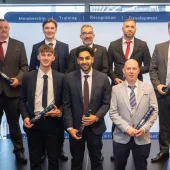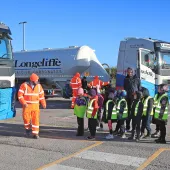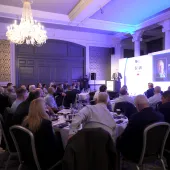Quarrying Health and Safety in Focus

First published in the March 2016 issue of Quarry Management as Health and Safety in Focus.
Callam Brough reports on the fourth annual safety conference hosted by IQ’s Derbyshire branch and the HSE at the Proact Stadium in Chesterfield
On 7 October 2015 the Derbyshire branch of the Institute of Quarrying, in conjunction with the Health and Safety Executive (HSE), hosted its fourth annual safety conference at the Proact Stadium, Chesterfield, at which a variety of presentations were delivered by a number of industry experts. Attended by more than 130 delegates and mirroring the conference held by the Yorkshire branch in September, the event began with an introduction from Richard Noble of the HSE and Derbyshire branch chair Rebecca Slater.
Roy Bush kicked off the main conference proceedings with a presentation about hard targets and accident rates. While minor and major accident numbers remain small and similar to other industries, fatal accidents are 11 times the all-industry rate and rising. Roy challenged delegates to reflect on their position on the DuPont Bradley Curve, ie whether they are reactive, dependant, independent or interdependent. This led on to Quarry Regulation 40 – Workforce engagement/involvement and the question of whether the workforce is independent and suitably trained? Roy finished by talking about the new QNJAC Leadership qualification which includes communication, inductions, education and incident investigation.
Mike Phillips followed with a presentation entitled: ‘Growing Professionalism Leads to the Industry’s Future’, which began with an account of how, in the midst of a recession which saw the sector contract by 42%, the industry adapted by altering operational practices, businesses, and employee focuses. This, he said, was demonstrated by the success of the PRIME project, which was launched at Hillhead in June 2014 and provides recognition for highly trained individuals through the IQ’s new Technician membership grade (TMIQ), thereby transforming the status of operatives and supervisors. PRIME has benefited the industry by raising its profile, making it more attractive to employees, maximizing employee retention, and creating a professional workforce. Mike also talked about the introduction of mandatory CPD and the launch of the new CPD app, which allows IQ members to record their CPD electronically.
Colin Nottage of Influential Management Group gave a talk entitled ‘Practically Controlling Respirable Silica Dust’ in which he reinforced the seriousness of the issue by stating that whilst approximately 150 people die in industrial accidents each year, an estimated 500 people die from the effects of respirable crystalline silica. He presented a video of a person using a sander both with and without Tyndall lighting to make fine airborne dust particles visible; the comparison was shocking and emphasised the risk that RCS poses to health. Colin advised delegates to complete a full COSHH assessment and two-step risk assessment by splitting the site into separate areas, then assessing the risk, which should include simple controls such as good housekeeping, removal of cloth seating and minimal drop distances on conveyors. Guidance on health surveillance is also available on the HSE website; this features chest x-rays and lung-function tests.
After a coffee break, Alan Millband of Howes Percival LLP raised the question: Is leadership a legal requirement under health and safety law? His talk began by defining a good leader and the qualities that effective leaders possess. After a closer look at the law it was noted that the word ‘leadership’ is absent from relevant statutory health and safety provisions – HASAWA 1974 and Quarries Regulations 1999, despite the fact that responsible persons are accountable under health and safety law. Alan concluded that, in theory, leadership is not a requirement, but in practice it is essential. Safety cannot be ensured without a good health and safety culture, and a good health and safety culture cannot exist without good leadership. He finished with a final thought: ‘Good leadership doesn’t fall back at setbacks, it gets stronger’.
Phil Robinson of Amber Valley Blasting Services showed delegates how to manipulate gravity in ‘Gravity is My Friend.’ His presentation featured videos demonstrating the methods of shattering, toppling and progressive collapse. The technique used depends on the outcome of preparations which take into account height and location of the structure, pre-weakening, exclusion zones, protection methods, and a test blast to calculate the size of the charge. The variety of explosives and detonators available also need to be considered, including delays that can direct blasts and control the spread of debris, along with environmental effects such as ground vibration and air overpressure.
Adrian Wilkinson of Quarry Design discussed ‘Drones – The Law and the Benefits’, which demonstrated the safety benefits when surveying liquid tips and large stockpiles using a drone. He also explained how ‘point cloud’ models, which use point spacings of 15mm to build a 3D image, are ideal for conducting rockfall assessments and detailed face inspections. However, the law requires that pilots are certified to fly UAVs and have specific insurance and permission to fly in the area. This is due to an increasing number of incidents, as today there are far more unlicensed drones than licensed ones. Another challenge is the huge amount of data that drone surveys produce; this can be as large as 20GB per survey.
After lunch, Richard Noble provided case studies of two incidents. The first, a fatality involving a dumptruck that occurred on 26 July 2012, reminded delegates of the importance of daily inspections and housekeeping, especially in areas where items of mobile plant are operating. The second was a safety failing at the beginning of January 2014 by a company that did not report a significant failure of a quarry face under RIDDOR, which resulted in the site office and machinery sliding from the top of the quarry to the bottom. Both incidents could have been prevented had the correct regulations and procedures been followed.
The final presentation, by Stewart McNaughton of McNaughton Consultancy & Training, was entitled: ‘Hand Arm Vibration Syndrome...What’s the Problem?’. This highlighted the severity of hand arm vibration syndrome, as 50% of all recorded occupational industrial diseases are HAVS related. Symptoms begin with tingling and numbness and can lead to vascular, neurological and musculoskeletal damage. Given that there is no cure, prevention is the only option. Stewart questioned current legislation that requires health surveillance to be carried out annually and compared it against continuous monitoring, which is seen as an improved preventative measure as symptoms have been known to develop in six months or less.
The conference closed with thanks to the event organizers, venue staff and speakers, who delivered a number of excellent presentations, passed on important messages and raised some interesting questions. The 2015 conference was also Richard Noble’s last before his retirement at the end of the year. Having been with the HSE since 1986, Richard started the safety conference four years ago. Thanking him for his work with the Institute and the industry over the years, Rebecca Slater, chair of the Derbyshire branch, presented him with a Rochdale AFC jacket and wished him all the best for the future.
- Subscribe to Quarry Management, the monthly journal for the mineral products industry, to read articles before they appear on Agg-Net.com








